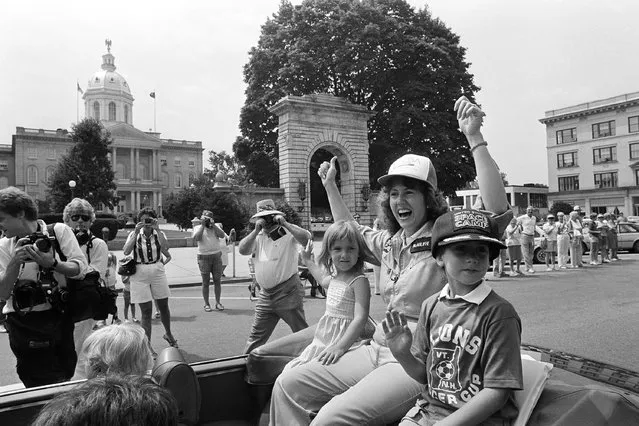
NASA's choice for the first in Space, Christa McAuliffe, rides in front of the New Hampshire with her daughter Caroline and son Scott. McAuliffe, a social teacher at Concord High School, riding, Saturday, July 21, 1985 at Concord in a Lions Club parade. (Photo by Jim Cole/AP Photo)
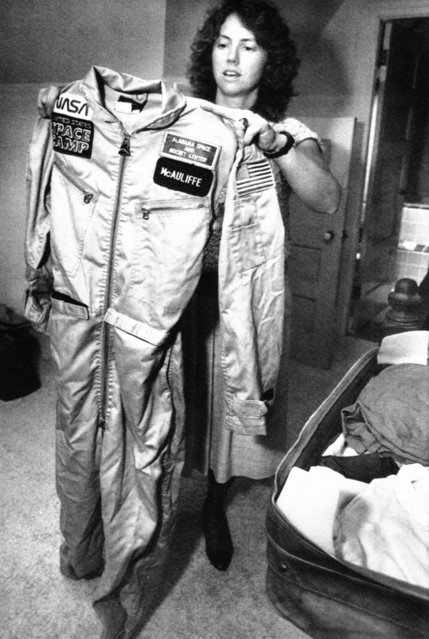
High school teacher Christa McAuliffe folds her training uniform as she packs for Houston in Concord, September 8, 1985. McAuliffe will leave on Sunday for NASA training for her January flight aboard the space shuttle as the first private citizen to ride in space. (Photo by Jim Cole/AP Photo)
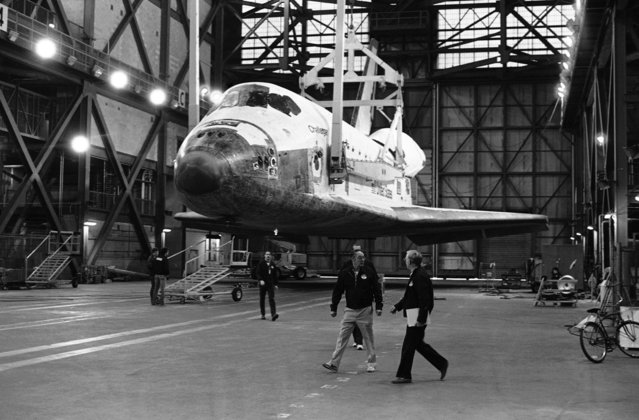
Space Shuttle Challenger beings the process of being transferred to the high bay of the Vehicle Assembly building at Kennedy Space Center on December 17, 1985 where it will be stacked with the solid rocket booster and external tank in preparation for the scheduled for launch as Mission 51-L in January 1986. (Photo by Terry Renna/AP Photo)
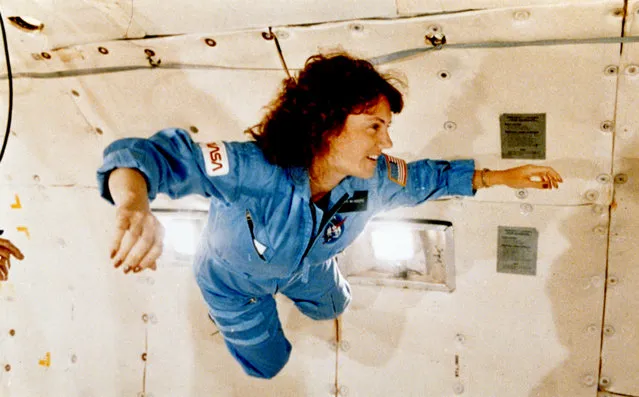
Christa McAuliffe gets a preview of microgravity on NASA's specially equipped KC-135 “zero gravity” aircraft on January 13, 1986. The plane flies in a parabolic pattern that provides short periods of weightlessness. For some people, those bouts of zero-G can induce nausea – which is why the airplane was nicknamed the “Vomit Comet”. (Photo by Getty Images/Science & Society Picture Library)
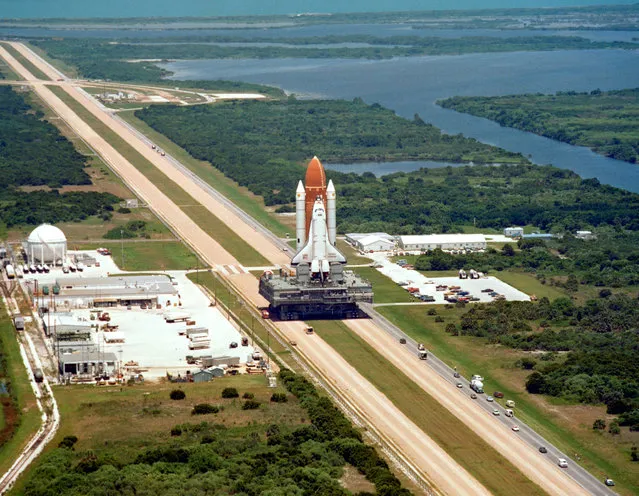
The shuttle Challenger is delivered to its launch pad at NASA's Kennedy Space Center atop a mobile crawler-transporter. (Photo by NASA)
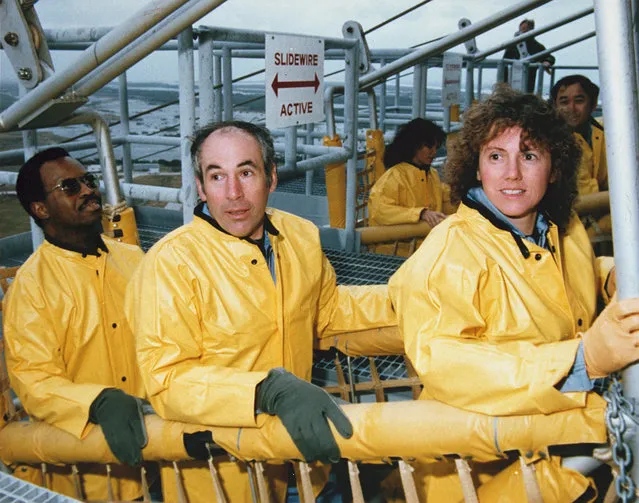
The STS-51L Challenger flight crew emergency egress training in the slide wire baskets. From left to right they are: Mission Specialist, Ronald McNair, Payload Specialist, Gregory Jarvis, Teacher in Space Participant, Christa McAuliffe. Directly behind them: Mission Specialist Judy Resnik and Mission Specialist, Ellison Onizuka. (Photo by NASA)

Crew members of mission STS-51L stand in the White Room at Pad 39B following the end of the Terminal Countdown Demonstration Test (TCDT). From left to right they are: Teacher in Space Participant, Sharon “Christa” McAuliffe, Payload Specialist, Gregory Jarvis, Mission Specialist, Judy Resnik, Commander Dick Scobee Mission Specialist, Ronald McNair, Pilot, Michael Smith and Mission Specialist, Ellison Onizuka. (Photo by NASA)
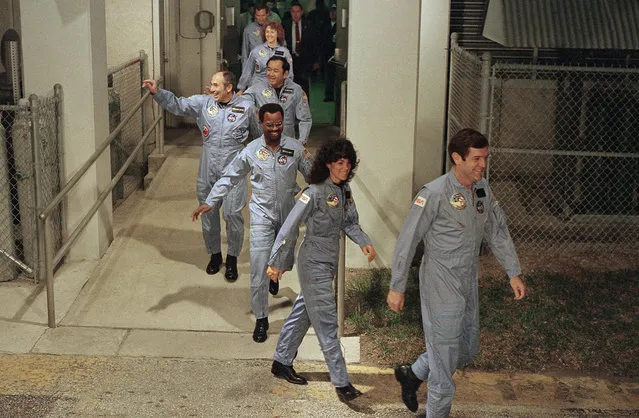
The crew for the Space Shuttle Challenger Flight 51-L, leaves their quarters for the launch pad, January 27, 1986 in Kennedy Space Center, Florida. Front to back the commander Francis Scobee, Mission Spl. Judy Resnick, Mission Spl. Ronald McNair, Payload Spl. Gregory Jarvis, Mission Spl. Ellison Onizuka, teacher Christa McAuliffe and pilot Michael Smith. (Photo by Steve Helber/AP Photo)
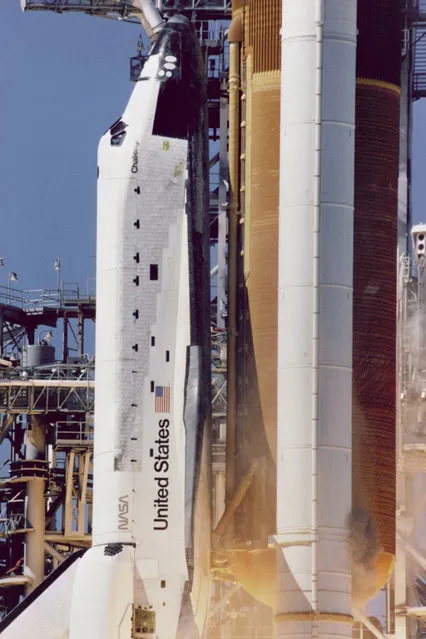
Close-up view of the liftoff of the Shuttle Challenger on mission STS-51L taken from camera site 39B-2/T3. From this camera position, a cloud of grey-brown smoke can be seen on the right side of the Solid Rocket Booster (SRB) on a line directly across from the letter “U” in United States. This was the first visible sign that an SRB joint breach may have occured. On January 28, 1986 frigid overnight temperatures caused normally pliable rubber O-ring seals and putty that are designed to seal and establish joint integrity between the Solid Rocket Booster (SRB) joint segments, to become hard and non- flexible. At the instant of SRB ignition, tremendous stresses and pressures occur within the SRB casing and especially at the joint attachmentment points. The failure of the O-rings and putty to “seat” properly at motor ignition, caused hot exhaust gases to blow by the seals and putty. During Challenger's ascent, this hot gas “blow by” ultimately cut a swath completely through the steel booster casing; and like a welder's torch, began cutting into the External Tank (ET). It is believed that the ET was compromised in several locations starting in the aft at the initial point where SRB joint failure occured. The ET hydrogen tank is believed to have been breached first, with continuous rapid incremental failure of both the ET and SRB. A chain reaction of events occurring in milliseconds culminated in a massive explosion. The orbiter Challenger was instantly ejected by the blast and went askew into the supersonic air flow. These aerodynamic forces caused structural shattering and complete destruction of the orbiter. Though it was concluded that the G-forces experienced during orbiter ejection and break-up were survivable, impact with the ocean surface was not. Tragically, all seven crewmembers perished. (Photo by NASA)
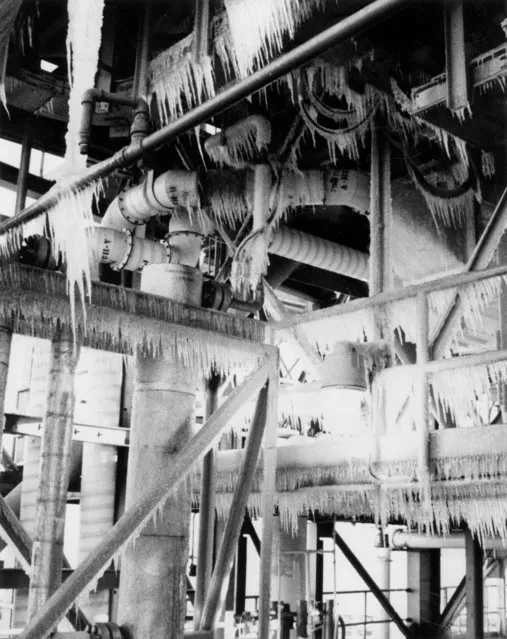
On January 28, 1986, the Space Shuttle Challenger and her seven-member crew were lost when a ruptured O-ring in the right Solid Rocket Booster caused an explosion soon after launch. On the day of Space Shuttle Challenger's launch, icicles draped the Kennedy Space Center. The unusually cold weather, beyond the tolerances for which the rubber seals were approved, most likely caused the O-ring failure. (Photo by NASA)
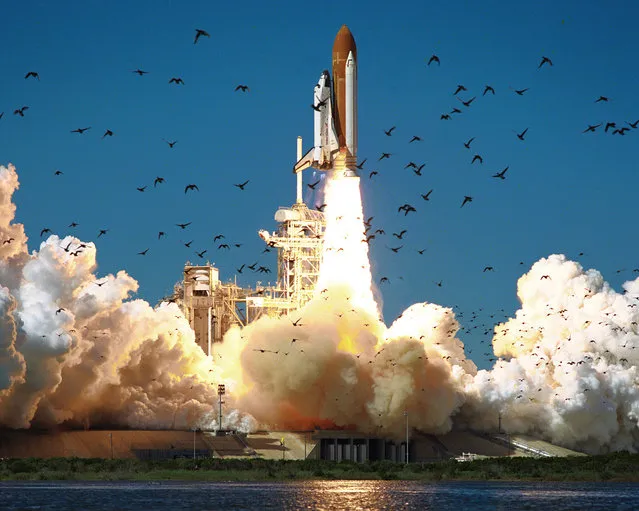
A wide-angle view shows the ascent of the shuttle Challenger on January 28, 1986. In the seconds after ignition, the rocket engines' hot blast began the process of destruction. (Photo by NASA)
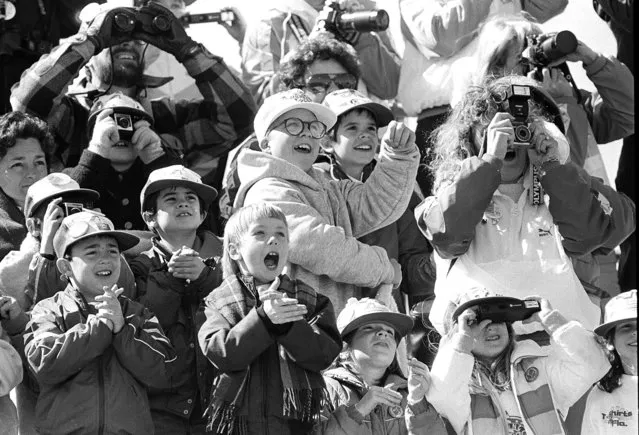
Classmates of the son of America's first school teacher astronaut cheer as the space shuttle Challenger lifts skyward from Pad 39B, January 28, 1986. Their delight soon turned into horror as the shuttle exploded about 70 seconds into flight. The boy in the white hat and glasses at center is not a schoolmate but is Peter Billingsley, spokesman for the young astronaut program. (Photo by Jim Cole/AP Photo)
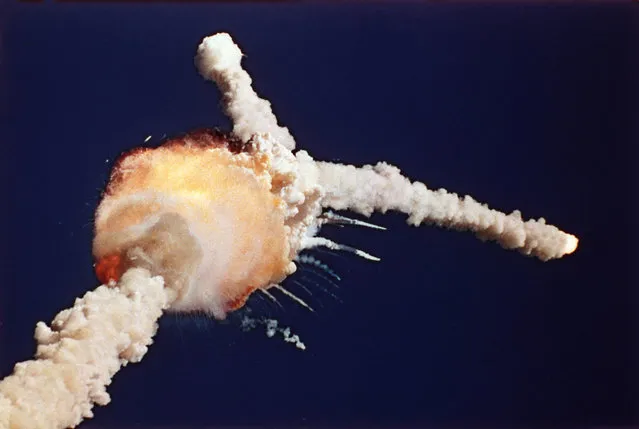
The space shuttle Challenger explodes shortly after lifting off from Kennedy Space Center Tuesday, January 28, 1986. All seven crew members died in the explosion, which was blamed on faulty o-rings in the shuttle's booster rockets. The Challenger's crew was honored with burials at Arlington National Cemetery. (Photo by Bruce Weaver/AP Photo)
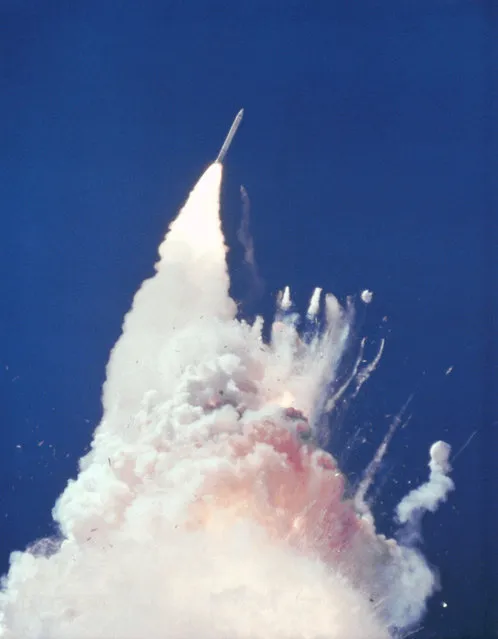
At about 76 seconds, fragments of the Orbiter can be seen tumbling against a background of fire, smoke and vaporized propellants from the External Tank. The left Solid Rocket Booster (SRB) flys rampant, still thrusting. The reddish-brown cloud envelops the disintergrating Orbiter. The color is indicative of the nitrogen tetroxide oxidizer propellant in the Orbiter Reaction Control System. On January 28, 1986 frigid overnight temperatures caused normally pliable rubber O-ring seals and putty that are designed to seal and establish joint integrity between the Solid Rocket Booster (SRB) joint segments, to become hard and non- flexible. At the instant of SRB ignition, tremendous stresses and pressures occur within the SRB casing and especially at the joint attachment points. The failure of the O-rings and putty to “seat” properly at motor ignition, caused hot exhaust gases to blow by the seals and putty. During Challenger's ascent, this hot gas “blow by” ultimately cut a swath completely through the steel booster casing; and like a welder's torch, began cutting into the External Tank (ET). It is believed that the ET was compromised in several locations starting in the aft at the initial point where SRB joint failure occured. The ET hydrogen tank is believed to have been breached first, with continuous rapid incremental failure of both the ET and SRB. The chain reaction of events occurring in milliseconds culminated in a massive explosion. The orbiter Challenger was instantly ejected by the blast and went askew into the supersonic air flow. These aerodynamic forces caused structural shattering and complete destruction of the orbiter. Though it was concluded that the G-forces experienced during orbiter ejection and break-up were survivable, impact with the ocean surface was not. Tragically, all seven crewmembers perished. (Photo by NASA)
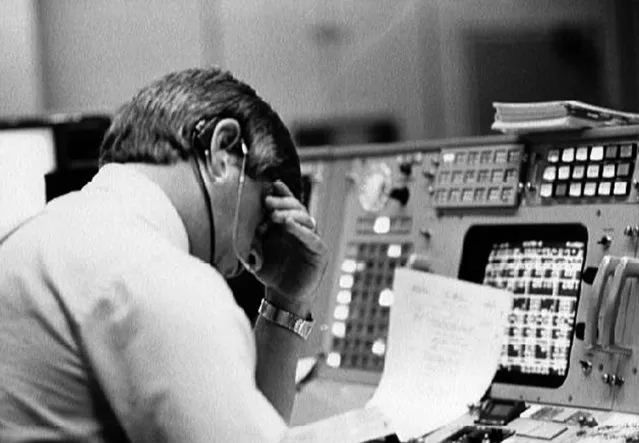
Flight director Jay Greene studies data at his console inside Johnson Space Center's Mission Control Center in Texas, just minutes after the announcement that Challenger's ascent was not nominal. (Photo by NASA)
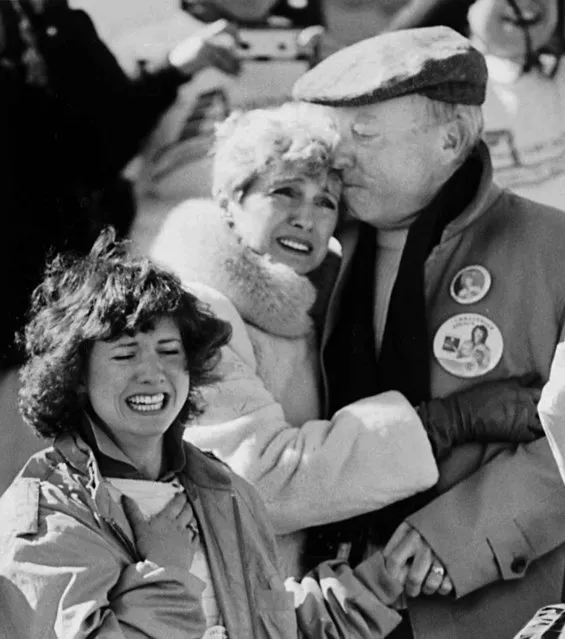
The family of Christa McAuliffe, a teacher who was America's first civilian astronaut, react shortly after the liftoff of the Space Shuttle Challanger at the Kennedy Space Center, Tuesday, January 28, 1986. Shown are Christa's sister, Betsy, front, and parents Grace and Ed Corrigan. (Photo by Jim Cole/AP Photo)
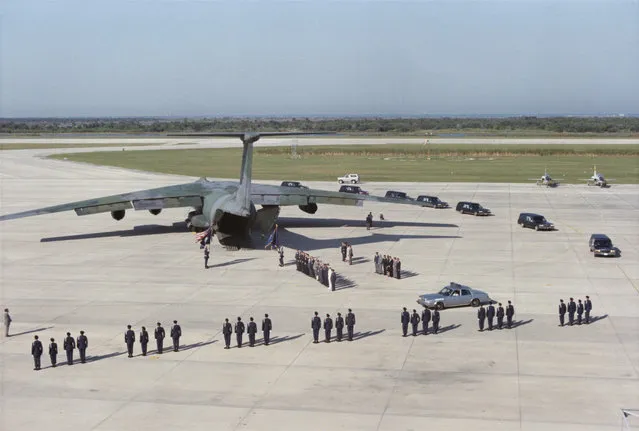
The remains of the crew of the space shuttle “Challenger” are moved from the Shuttle Landing Facility at the Kennedy Space Center on Merritt Island, Florida, to Dover Air Force Base in Delaware, on board a Military Airlift Command C-141, 29th April 1986. NASA officials, a military guard of honour and escorts from the Astronaut Office are present for the departure. The seven crew members of the 'Challenger' died on 28th January 1986, when the shuttle broke up shortly after take-off. (Photo by Space Frontiers/Getty Images)
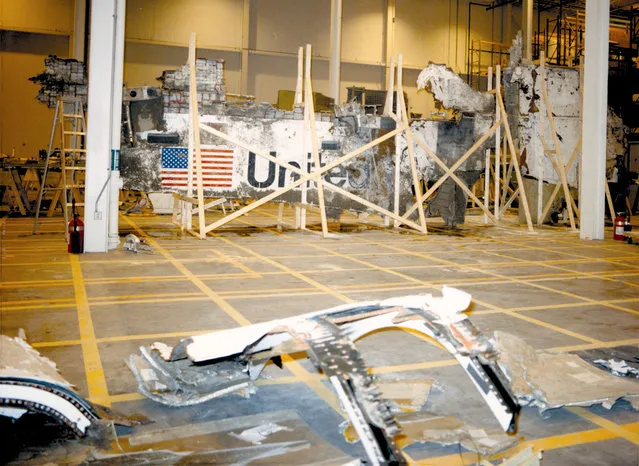
On January 28, 1986, the Space Shuttle Challenger and her seven-member crew were lost when a ruptured O-ring in the right Solid Rocket Booster caused an explosion soon after launch. Search and recovery teams located pieces of both the left and right sidewall of the Shuttle during the months long retrieval effort that followed. While heat and fire damage scarred the right sidewall, the left sidewall, depicted here, escaped the flames and suffered from only overload fractures and deep gouge marks. The largest intact piece formed part of the payload bay sidewall and measured approximately thirty by twelve feet. (Photo by NASA)
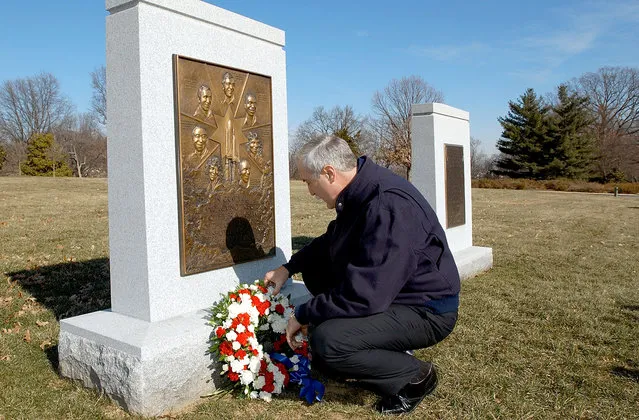
NASA administrator Sean O'Keefe lays a wreath at the Space Shuttle Challenger Memorial January 28, 2003 at Arlington National Cemetery in Virginia. The Challenger exploded shortly after take-off January 28, 1986, killing the entire crew. They are: Michael Smith, Ronald McNair, Ellison Onizuka, Judith Resnick, Dick Scobee, Greg Jarvis and Christa McAuliffe. O'Keefe also used the occasion to remember the crew of Apollo 1, Roger Chaffee, Ed White and Gus Grissom, who died in a fire on the launch pad on January 27, 1967. (Photo by Bill Ingalls/Getty Images/NASA)
28 Jan 2016 12:28:00,
post received
0 comments
